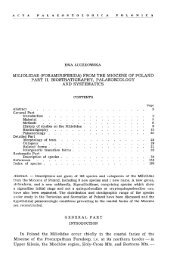The skull of Velociraptor - Acta Palaeontologica Polonica
The skull of Velociraptor - Acta Palaeontologica Polonica
The skull of Velociraptor - Acta Palaeontologica Polonica
You also want an ePaper? Increase the reach of your titles
YUMPU automatically turns print PDFs into web optimized ePapers that Google loves.
212 Skull <strong>of</strong> <strong>Velociraptor</strong>: BARSBOLD & OSMOLSKA<br />
process in Herrerasaurus. In Dromaeosaurus, the caudal margin <strong>of</strong> the caudodorsal ex-<br />
tension <strong>of</strong> the splenial dorsally contacts the rostral margin <strong>of</strong> the prearticular, just as it<br />
does in <strong>Velociraptor</strong> (Barsbold 1983: fig. 13a). Contacts <strong>of</strong> the caudodorsal and<br />
caudoventral flanges <strong>of</strong> the splenial in Deinonychus is erroneously reconstructed by<br />
Ostrom (1969b: fig. 16), among others, the Meckelian fenestra not being marked. How-<br />
ever, judging from the incised rostral margin <strong>of</strong> the splenial, identical with those in<br />
Drornaeosaurus and <strong>Velociraptor</strong>, this fenestra had to be present also in Deinonychus.<br />
Thus differences with the <strong>Velociraptor</strong> mandible may be less significant than implied by<br />
Ostrom's reconstruction. <strong>The</strong> angular in Deinonychus is similar, although the contact<br />
surface for the splenial and the floor <strong>of</strong> the Meckelian canal are shallower. In Dromaeo-<br />
saurus, the angular is relatively shallower: it forms at most a third <strong>of</strong> the height <strong>of</strong> entire<br />
labial wall <strong>of</strong> the mandible. In this respect, it resembles more the angular in some<br />
carnosaurs. <strong>The</strong> most rostral portion <strong>of</strong> the prearticular is not preserved in Deinonychus.<br />
In Dromaeosaurus, the rostral embayment <strong>of</strong> the prearticular is less deep and the<br />
splenial process more stout. <strong>The</strong> coronoid is very similar in Dromaeosaurus and<br />
<strong>Velociraptor</strong>, although the furrow along the rostral margin seems to be lacking in the for-<br />
mer. <strong>The</strong> coronoid is unknown in Deinonychus. <strong>The</strong> surangular in Deinonychus is repre-<br />
sented by an isolated caudal fragment and it differs from this bone in <strong>Velociraptor</strong> in the<br />
presence <strong>of</strong> a ridge that projects medially along the dorsal border <strong>of</strong> the adductor fossa.<br />
<strong>The</strong> marginal portion <strong>of</strong> the surangular is well exposed medially in ZPAL MgD-1/97 and<br />
it is flat, devoid <strong>of</strong> any ridge. In Dromaeosaurus, the surangular is relatively deeper be-<br />
hind the external mandibular fenestra and it forms caudally a larger portion <strong>of</strong> the ventral<br />
margin. <strong>The</strong> surangular foramen is much smaller in this genus than that in <strong>Velociraptor</strong>.<br />
<strong>The</strong> articular in <strong>Velociraptor</strong> seems similar to the articular in Dromaeosaurus. A com-<br />
parison <strong>of</strong> casts <strong>of</strong> the right surangular (YPM 5234) and the right articular (YPM 5232)<br />
<strong>of</strong> Deinonychus (the two bones may come from the same mandible, because they articu-<br />
late perfectly with each other) with our specimens <strong>of</strong> <strong>Velociraptor</strong> shows that the articu-<br />
lar on Ostrom's figure (1969b: fig. 22) is incorrectly oriented. <strong>The</strong> 'medial' surface <strong>of</strong><br />
the bone (fig. 22a) is actually the ventral one, while that determined as lateral (fig. 22b)<br />
appears to represent, in fact, the slanting caudal extremity <strong>of</strong> the bone. <strong>The</strong> surface indi-<br />
cated on this figure as the 'area overlain by the surangular' was located dorsal to the tu-<br />
ber labeled by Ostrom as the insertion site <strong>of</strong> rn. depressor mandibulae; presumably it<br />
faced caudodorsally, as in <strong>Velociraptor</strong>. This surface occurs in many theropods, e.g., in<br />
the Tyrannosauridae (Osborn 1912: fig. 4) and Bagaraatan, although it is rather vertical<br />
in the tyrannosaurids, and slants slightly in Bagaraatan (Osm6lska 1996: fig. 2e, f).<br />
Dentition<br />
<strong>The</strong>re are four premaxillary teeth in all our specimens, and they are weakly curved. <strong>The</strong> two rostralrnost<br />
teeth preserved in GIN 100124 are <strong>of</strong> about equal size and nearly twice as long as the third and fourth<br />
teeth (Fig. 3A). <strong>The</strong> maxilla bears 11 teeth and within the rostral half <strong>of</strong> the tooth row, every second<br />
tooth is longer than the neighbouring teeth. As a result, the tips <strong>of</strong> the functioning teeth are separated by<br />
large spaces. <strong>The</strong> maxillary teeth are slender and caudally curved. Carinae <strong>of</strong> these teeth are poorly pre-<br />
served and it is only possible to note that serrations on the mesial carina are distinctly smaller than those<br />
on the distal carina. <strong>The</strong> denticles on the mesial carina are strongly worn and cannot be measured.<br />
Those on the distal carina are better preserved, and there are nine denticles per 2 rnm along the medial<br />
section <strong>of</strong> the carina. <strong>The</strong> dentary teeth cannot be counted in specimens at our disposal, because mandi-<br />
bles are forced under the <strong>skull</strong>. However, in the holotype the number <strong>of</strong> dentary teeth is 14 to 15.

















